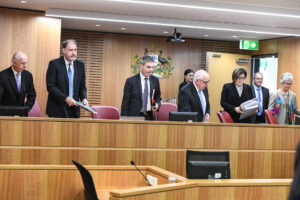
Treasurer Josh Frydenberg’s recent declaration – that wage-restrained workers need simply participate in the so-called “Great Reshuffle” to find better-paid jobs – underscores just how disconnected the federal government is from the harsh realities facing many Australian workers.
With shades of former treasurer Joe Hockey advising youth priced out of housing to “get a good job that pays good money”, Mr Frydenberg’s rhetoric drives two key misconceptions about labour markets: That workers can just pull higher-paid jobs off the shelf, and that “bad” jobs will always exist – presumably for someone else to do.
It’s exactly the type of thinking fuelling the workforce crisis in the aged-care system. But real change on jobs requires more than individualistic blame games from government.
To prove the Big Switch is the real path to better jobs, the government is relying on pre-Omicron data showing an increase in job switching. But there’s considerable cause for scepticism.
The end of 2021 was a period of post-lockdown growth, supported by government stimulus, pent-up consumer spending, and the consensus that two doses would deliver our #HotVaxSummer.
Omicron trashed those settings. And with the Treasurer drawing a line through further pandemic stimulus this week, strong labour demand could expire come budget time.
Across the whole economy, intended quit rates are low.
The percentage of workers who say they don’t expect to be with the same employer in the next 12 months hasn’t increased at all on pre-pandemic levels. That’s not good.
Change is as good as a holiday. It’s also good for wages growth, improving job quality and productivity. We need more workers leaving bad jobs.
But when the fires of insecure work and below-poverty welfare payments rage around you, you cling tight to the job you’re in.
And that’s what people are doing, with about 50 per cent of workers experiencing some dimension of insecure work.
Millions of people’s lives are defined by the fortnightly staff roster, a text message from a labour hire agency or the impending doom of a short-term contract ending.
The treadmill of insecure work fuels anxiety and makes planning for a decent life nigh impossible.
The government’s apparent faith in free-market fantasies makes them equally out of touch as not knowing the price of bread, petrol or RATs.
While workers toil, the price of everyday items increases faster than their wages, leaving people worse off.
Labour’s share of national income reached a record low of 46 per cent of GDP in June. Insecure work fuels this low-wages crisis. Casuals earn 26 per cent less per hour than permanent workers – and half as much per week.
The reality is that the human cost of unchecked employer power is enormous. And there are multiple indicators that this power has deepened over the pandemic.
Centre for Future Work research found the average worker was squeezed for 6.1 hours unpaid overtime per week in 2021 – a substantial increase on 2020.
People are working more while their wages stand still.
Despite recent employment growth there are enormous numbers of people wanting more hours, with more than two million people either underemployed or “marginally attached” to the job market.
This creates conditions for employers to refuse normal wage increases and flip good jobs into insecure ones.
High-paid professionals in specialist roles may have the power to switch jobs alone, but the bulk of workers need our institutions to facilitate change: Social security payments, collective bargaining, a skills system and early childhood care and education.
Years of privatisation and anti-union policies have eroded those key supports.
The result is only 11 per cent of private-sector workers are covered by a current collective agreement. Australians are navigating this once-in-100-year crisis without support for their economic interests.
Women especially so. Infection burden – both of workers and their loved ones – is being borne disproportionately by the same feminised essential workforce that must pull out of paid work to care for those affected by COVID.
With future mortgages to pay, and kids to clothe, feed and school, people must protect their future capacity to earn.
Unsurprisingly, sectors with the highest number of job vacancies are among the most COVID-exposed like health care, and accommodation and food services.
There are lots of part-time jobs in high-vacancy sectors. They’re also feminised and in the bottom half of industries by average weekly earnings.
Decades of “low road” employment strategies undermined the quality jobs, stability, trust, and institutions we needed in this pandemic.
Desperately sending the military into aged care reflects the fact that the sector has been underpaid, privatised and hollowed out over decades.
For pay-squeezed aged-care workers, the irony of the Treasurer’s “Great Reshuffle” is not lost.
Do they need to join the ADF to get a better job in their sector?
Real change on the erosion of good jobs requires more than slogans, blame games, and rolling ADF stand-ins.
COVID calls for a reimagination of how we work.
Let’s make jobs plentiful, safer, more secure and better paid – and invest in our social institutions which support workers and the economy.
Alison Pennington is senior researcher at the Australia Institute’s Centre for Future Work and associate editor of the Journal for Industrial Relations. @ak_pennington
Between the Lines Newsletter
The biggest stories and the best analysis from the team at the Australia Institute, delivered to your inbox every fortnight.
You might also like
If business groups had their way, workers on the minimum wage would now be $160 a week worse off
Had the Fair Work Commission taken the advice of business groups, Australia lowest paid would now earn $160 less a week.
The continuing irrelevance of minimum wages to future inflation
Minimum and award wages should grow by 5 to 9 per cent this year
Australia’s parliaments closing in on gender parity, in spite of coalition “women problem” – new analysis
New analysis by The Australia Institute reveals that, following the recent federal election, there are now more women than ever in Australia’s nine parliaments, but the coalition’s so-called “women problem” remains.


